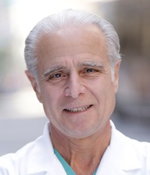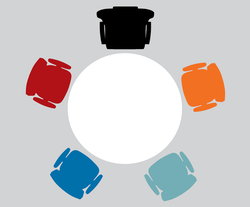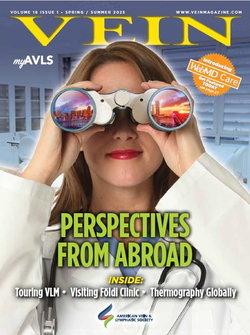Moderated by Steve Elias, MD, FACS, FACPh
Participants: Suresh Vedantham, MD, FSIR (Principal Investigator), William (Bill) Marston, MD, Raghu Kolluri, MD and Darren Schneider, MD
The landmark ATTRACT trial revealed that the addition of catheter-based intervention to standard-of care anticoagulation failed to significantly decrease the occurrence of post-thrombotic syndrome in patients who received this treatment strategy, compared to its occurrence in patients who received anticoagulation alone. The information is considered to be hypothesis generating. But what does the ATTRACT trial not tell us—and where can we go from here?
What did ATTRACT NOT tell us?

Steve Elias: I want to use the ATTRACT trial as a stepping-off point to what we may think about in the future. My first question is what did the ATTRACT trial not tell us?

Bill Marston: Any prospective randomized trial is always going to have a narrow set of things that it’s able to test. All we know from this trial is that all patients who present with DVT from the femoral up to the iliac cannot be told that they’ll do better if they’re treated with a pharmacomechanical lysis. That’s really the sole major outcome from the study.

Raghu Kolluri: But there are a lot of other things it did not tell us. It did not tell us about the interaction of the cardiovascular system as a whole. I believe when you take the Villalta score and apply that in a congestive heart failure clinic, you’ll probably get a ton of positive numbers in that too.
It also did not tell us whether these results are applicable to patients who are morbidly obese. And it did not tell us whether a bunch of these people, or people with DVT and concomitant superficial venous insufficiency, have any benefits with this.

Darren Schneider: All of us in our practices have been convinced that we’ve had patients who did benefit from pharmacomechanical thrombolysis—particularly, patients with severe proximal DVTs. So, although the design was ‘all-comers,’ because femoral as well as iliofemoral DVTs were included, the trial did not show a benefit of intervention versus medical therapy.
Since we all still believe there are some patients who would benefit from this, we should continue to look at which subset of DVT patients may benefit.
Steve: Yes, and Suresh, tell me one thing ATTRACT did not tell us.

Suresh Vedantham: First of all, without a doubt, additional detailed sub-grouping and analysis of certain groups of patients is ongoing right now, and I will have that data later in the year. But as far as what ATTRACT didn’t tell us, what’s troubling about ATTRACT is that even with all the sub-grouping, so many of these patients got post-thrombotic syndrome (PTS). How do we know who is going to get PTS? We’re focusing on factors that relate to the anatomy and where the clot is, but genetic and other factors undoubtedly play a role here.
With the length of trial and the budget, it’s unfortunate we did not collect blood samples for genetic testing and that kind of thing. The next trial we do, we will not let that one slip. How do we get better at figuring out what the other mechanisms involved are? You have two randomized trials now (ATTRACT and CAVENT) and neither one of them found less than 40 percent PTS, even in the lysis patients.
Steve: And I think that’s one thing the ATTRACT trial, and also any trial, didn’t tell us—it didn’t tell us why we can’t do any better. I mean really, with the DVT patients, in both arms, there was 47 percent and 48 percent who got post-thrombotic syndrome of some manner and to some degree. If we were treating another disease and we only got 50 percent of the people better, that would be a little scary.
Can we do better?
Steve: Can we do better or is this something that we just accept? Do we accept that people who get DVT are going to get some element of PTS 50 percent of the time?
Bill: The key thing here is what Suresh said about all the other data that they are going to bring to us. My initial answer was sort of facetious in the sense that the pure statistical primary outcome is only a very small slice of what this study and all its data are going to provide to us.
At the end of the day, we can’t treat people solely by using the results of prospective randomized trials. We’ve got to treat them via the imperfect data we have, which is the art of being a physician. Using all this secondary data that’s going to come out will hopefully inform us as to which patients may really benefit from aggressive intervention and those who won’t.
Darren: We need to figure out what are the best practices here. What are the ideal techniques if we are going to do pharmacomechanical thrombolysis and should we be stenting all of these patients? Which are the ideal anatomies and clinical circumstances as well as critical factors for intervention? Should we only intervene on the patients who are at the greatest risk of developing really severe PTS? Are those the ones who are going to benefit the most?
This is just the beginning here, and we really have to refine our techniques. We really have to refine our clinical judgment and selection of whom we treat. In this trial, like Suresh pointed out, we treated all-comers—obese, CHF patients and those with a variety of anatomies, including the patients with femoral popliteal DVT as well. There is a lot we still need to learn, and I think that’s the opportunity.
Steve: All right, so let’s talk a little. Raghu, do you want to add anything to this?
Raghu: Yes. As the token medical guy in the group here…
Steve: You are not the token medical guy, you are the medical guy.

Raghu: We all have seen people come in and we swear that it’s PTS. We do venous insufficiency tests. We do IVUS, we do angiograms, and we find these patients who we swear are post-thrombotic syndrome or venous insufficiency-like patients, but everything turns out normal. We all have seen that. It’s not uncommon.
What I am trying to say is, after this trial, Suresh and his team had this powered for 30 percent PTS rates and with a reduction of 10 percent. Am I correct, or was it 20 percent?
Suresh: We tested for a one-third reduction in two-year PTS occurrence from an assumed control arm rate of 30 percent, which turned out to be a bit low, obviously. So, the power was plenty.
Raghu: Exactly. The power was plenty. The design was perfect, in my mind. For the contemporary design, when you started out, Suresh, maybe in 2005-2006, it was perfect. It couldn’t have gotten any better. So why with close to 50 percent of femoral popliteal disease involved is there 47 percent PTS? That tells me that open vein is probably not holding up. There’s probably something more to it. That’s my take with the whole thing.
Although we got it powered very conservatively and did an excellent trial, we still have 47 percent or 49 percent PTS, even though we have femoral popliteal disease involved. You would expect that PTS rates are going to be lower if you involve femoral popliteal disease. So why is it so high? What I learned from this is that the open vein hypothesis probably doesn’t work; there is a lot more to it and we need to understand more about it. So that’s where I am coming from— the open vein hypothesis is not enough.
Suresh: It’s just part of the story. Absolutely. That is very clear and that’s from the CAVENT trial too, right? Forty-one percent of the lysed patients got PTS, right? So, there are obviously other mechanisms at play that we just haven’t worked out yet, and they also need to be investigated.
Do we need a better way to measure PTS?
Steve: What do you all think about the definitions that we use, Villalta score for example, to define what PTS is? Do we need to come up with a better way of really measuring PTS and how it really affects the patient, or are we comfortable with the measurement tools that we have currently?
Is this as good as we can get? Is this a realistic real-life thing for the patient, the Villalta score, VCSS, or DVT? I am now talking about for venous disease in general.
Suresh: Maybe the Villalta scale is too sensitive for certain things. Maybe that’s why we and others had such a high percentage of patients who tested positive for PTS. But that doesn’t explain the absence of a difference between treatment arms. The Villalta scale is, without question, the best validated scale for the diagnosis of new PTS, at present.
Contrary to what some less-informed people choose to say, this scale has had its acceptability, reliability, validity and responsiveness demonstrated in more than 20 published articles over the years.
Bill: This is another place where the study will help us out because you measured quality of life. We’ve got Villalta and we’ve got VCSS. We can start to look at what really matters for quality of life, and whether we need a better cut point or a better scale.
Steve: Sometimes I do all my VCSS on my patients, but I also ask them, “how are you doing? Are you able to do whatever you want to do in your life?” If they say, “I am all right,” I don’t care what the VCSS says. It’s about what that guy or that woman wants to do in their life. It doesn’t matter what that number is on a Villalta score.
Let me change a little bit. We talked briefly about technique. What do we need, if we assume part of improving a patient with the DVT is to get the vein open? What do we need from a technical viewpoint that’s better than what we have now? What modifications, what new technologies do we need to get more veins open and to stay open? Darren, you are big on technique; what do we need?
Darren: There is still a lot of room to have a better thrombectomy device for these large veins that we are treating. Yes, we can remove thrombus, but how complete is our thrombus removal in a large venous system? A lot of times, we have to resort to the adjunctive lytic infusions in patients. So, there certainly is room for improvement there.
Devices also that can remove thrombus without damaging valve leaflets and with minimum trauma to the veins themselves—while still being able to completely evacuate thrombus— may be some of the keys going forward.
Steve: Suresh, let me ask you a side question. Did some centers get better results than others? I am particularly talking about technique. There is no question some of us are better than others in doing things. I want to know about the best sites. What did they get in terms of clot clearance, versus the sites that didn’t quite do as well?
Suresh: We didn’t do any kind of analysis like that.
Steve: Wouldn’t that be nice if you could ask this guy or this woman, “hey, how come you’ve got this clot? What are you doing differently compared to another person?” And we can learn from this. We can all get to be the best of the best that was in your trial.
Suresh: Sure, but I think you’re making an assumption that the amount of clot removed is only due to the operator. There are a number of factors that might be influencing that go beyond the operator. In terms of the technical refinements that occurred after we started doing this, I think the one thing might be IVUS; intravascular ultrasound was used sporadically by some people, but near the end of the trial. I don’t think most people had it as a routine practice.
I also think IVUS is just used more for chronic patients than acute ones in general. But that’s not something everyone regularly used before either. So that may help a little bit, and it may have identified a few lesions that probably may not have been seen. That’s probably the one technical thing that has really changed during the last seven to eight years, maybe in a more meaningful way.
Darren: Getting to the point about IVUS, I personally think it is a critical tool to use when you’re doing these venous interventions. If you leave a residual stenosis, whether it’s from May-Thurner or some chronic residual thrombus, those patients are, at least in my opinion, more apt to fail. Then when I looked, there were also many types of stents that were used in the trial. There was a lot of variability in stenting technique with a patient receiving a covered stent, some patients receiving slotted-tube nitinol stents and many others treated with WALLSTENT devices.
What techniques are we lacking?
Steve: Talk to me a little bit about technique. What are we lacking currently in technique, and what do you feel is the optimal technique, in 2018, for clot removal?
Bill: The biggest challenge we have right now is definitely clot that’s a little older. If the clot is really fresh, i.e., the first few days, you can do anything. There are three or four methods that are going to clear that pretty quickly, but we see a lot of patients who are initially seen in the ER and treated as outpatients with LMWH, then they show up at their primary two to three weeks later and they are very symptomatic. Now they want us to do something, but by the time they get to us the clot is three or four weeks old or later, and we are not very successful then.
A technique that works on that older clot is really going to help us out with these patients. I think, Suresh, you can correct me if I am wrong, but those patients who are more symptomatic early on tend to have a higher rate of PTS.
Suresh: There was a little bit of a trend in that direction, yes. It didn’t reach statistical significance, but there was a trend that the people who had the highest Villalta scores up-front might have had a slightly greater treatment effect with thrombolysis.
What will optimize the patient for best results?
Steve: Raghu, once those of us who are surgeons and interventionalists here clear out the clot, what is it that you feel is going to medically optimize that patient for getting the best results? What are the things we need to keep in mind?
Raghu: Every major trial—including the ATTRACT trial and SOX trials—looked at compression therapy also. Everyone got the compression socks. Now, that’s not how vascular medicine folks are trained. We are trained to use medium-stretch compression wraps. I am sure the vascular surgeons are the same way. We should reduce the size of the leg first, and then put them in compression socks. I believe the enrollment is complete for the IDEAL DVT study, where they studied the individualized compression therapy as opposed to the SOX trial and the ATTRACT trial.
When you fit somebody with the compression socks, you are fitting them with circumference in mind at that time. The compression sock is not going to bring the edema down further; it just does not make physiological sense. We train our nurse practitioners to wrap the leg from the foot all the way to the thigh, for at least two to three weeks, until they come back to see us. At this point, we measure them for the compression sock.
It makes sense that you need to get the inflammation and swelling down before you get them into compression socks. That’s the way the IDEAL DVT study is designed. I am just waiting to see the results which are not out yet.
How would we design ATTRACT in 2018?
Steve: A lot of time has passed when Suresh first started thinking about this trial. If we were starting a trial today to answer the same question that you tried to answer way back then, how would we design the trial now in 2018 to answer the same question: “What’s better—lysis or anticoagulation?”
Suresh: From an eligibility standpoint, I think that you obviously want to focus on people with the most significant disease. We’ll get the specific data out of ATTRACT, but I think that it would have people who have common femoral or iliac thrombosis and who have the most severe symptoms. I think that’s going to be important, really.
In terms of designing the trial, I believe you still want a randomized design. I think you would look at disease severity and that could be measured in different ways, but health-related quality of life is a very important part. When we sub-group that out, I’d be very interested to see what we find, but I think that it’s going to have to be severitybased— not necessarily a binary kind of outcome.
Raghu: We had ESCHAR trial, which was a randomized-controlled trial for lower extremity venous ulcers. Then came the EVRA trial, which we are all eagerly waiting to be published, that challenges the ESCHAR trial. Would any of you start enrolling patients if we had a clinical trial randomizing patients to Coumadin along with heparin, to Coumadin alone and to placebo arms? There is no randomized controlled trial to date. ACCP guidelines, up until the seventh set, gave Coumadin and heparin a Grade 1A recommendation, and I think the eighth ACCP guidelines downgraded these recommendations.
When we know that one treatment benefits the patient more than the other, how do we know if a randomized trial is the way to go? I am not a trialist, but it just does not make sense to me. I can’t believe that the ATTRACT trial enrolled every consecutive young patient and the old patient coming in with iliofemoral DVT. This was true with CORAL trial and CREST trial as well.
Darren: We need to first complete the subset analyses in ATTRACT to learn as much as we can. We need to know what really is the appropriate target population, because I think the fact that we didn’t find the difference with the ATTRACT trial suggests that treating all-comers is not the answer. We’ve got to identify who in the population is likely to benefit. We at least have signals in that direction suggesting that it is going to be the patients with the most severe DVTs who have the biggest chance of getting PTS. It’s going to be those patients with iliofemoral DVT, and they really need to have significant pain and swelling to derive maximal benefit from the intervention.
To Bill’s point, we also need to make sure that we are getting to these patients early, when they are likely to benefit by removing the thrombus and we are able to do it effectively. Then we have to couple that with best practices that we can learn from the trial as well. So, we need to standardize how we are doing the imaging. If IVUS is the best way to image, then IVUS needs to be incorporated into the trial. Then we need to standardize how we access the patients to gain our percutaneous access.
We also need to come to a consensus on the best techniques and devices to use for mechanical thrombectomy, and to make sure that is standardized. This same approach also has to go for the post-procedure treatment. I know this was done in ATTRACT, and Suresh did a great job with the trial design, but we’ve learned a lot since then. We need to take everything that we’ve learned and then really target the population that we think is going to benefit with the best practices, then test that approach.
Bill: The sub-analyses and the specific reasons why patients failed are going to be critical. So, if we find they are re-thrombosing, then we need to do a better job with the outflow. We probably need to use IVUS routinely. Five years from now we’ll probably have a whole different set of devices and methods we can use. If they are failing because of reflux, then they probably need earlier treatment, and then maybe we’ll have a reflux device we can use in the future.
I would look at the trial in that sense because you are going to have a whole new wave of therapies not too long from now to employ.
Steve: To kind of summarize it, we’ve broken it up into identifying those people during pretreatment who we really feel—based on what the ATTRACT trial is going to tell us—are going to benefit, and then standardizing the treatment. We would then say “if you are going to enroll in this trial, then this is what you need to do when you have a patient who’s a candidate to be randomized.” If you are going to do mechanical thrombolysis, this is the way you do it, and this is what you need to do, whether it’s IVUS or whatever it is. Then post-treatment, to Raghu’s point, is the type of compression and post-treatment care. Standardizing it to, as Darren said, “the best practices in 2018” is something that maybe can narrow the focus.
Suresh, I think what the ATTRACT trial is going to identify—and everybody said this—is give us the people who are really going to be the best candidates, and not waste our time on those people who are not. Let us really focus on those people who we can truly help, and standardize what we need to do for those people going forward so that hopefully we’re not talking about a 49 to 51 percent rate of PTS. We are talking about a 25 percent or 20 percent rate.
Darren: It’s also how we’re measuring PTS as well. Like how everybody has commented, maybe it’s not Villalta; maybe we need to know the time to resolution of symptoms and how soon people were able to return to work and normal daily activity. Were they able to return to their previous work versus not being able to return to their normal work? Different patient-centered outcomes may be more important than subtle differences in the Villalta scale.
Suresh: The secondary analyses, cost-effectiveness, cost, etc., is data you are going to get soon. I’ll mention one other factor that we didn’t talk about, which is that what shocked me in this study is that the iliofemoral DVT patients didn’t do better with lysis. One thing to remember is that in a study like this, when enrolling them, we’re using iliofemoral as a surrogate for “lots of clot,” or extensive disease. Really though, if you had a one-centimeter clot in your common femoral vein, you are iliofemoral. If you had a 20-centimeter clot in your femoral popliteal side, you’re fem pop.
So, we’ve got to be really careful and remember that in this study, the whole point is that this is a firstline treatment population. It’s not like what we get in our clinical practices, where the medical physicians screen out the ones that respond to anticoagulation, then send us the ones that don’t. In addition to asking questions about illiofemoral/fem pop as segments, I believe asking what clot extent predicts PTS, doesn’t predict PTS, short or longer can help us pare it down further. I hope there will be another randomized trial, but I hope we have a really solid target for the next one.
Steve: I think that one of the points that comes out of the ATTRACT trial is that you are going to give us data on where we really need to focus, which patients we really need to think about helping and which ones who don’t need as much focus. For the patients who don’t need as much care, we just put them on anticoagulation and they are going to do as well as if you did something.
Suresh: Think about the vascular stroke care as well. The first big NIH trial was negative. Two other trials were negative. The thing was dead. Then the devices got innovated. They decided what’s the best anatomic group for treatment, who you should be treating, and then boom—three positive trials and now it’s the standard of care! So, hopefully someone else will come around and continue this, and really use the data effectively to do that.
Bill: To that point, Suresh, is there a way that from all the data from this trial that you can classify patients, not anatomically, but based on the extent of thrombus burden?
Suresh: The challenge of course is that iliac segment. The common femoral and femoral are easy, but I think you’d have to have all the patients imaged, using some type of cross-sectional or whatever imaging upfront. In the ATTRACT trial, we don’t have any assessment of the iliac vein in the control arm patients. They basically got ultrasounds and they got in the study, so we don’t really have that.
Raghu: Suresh, knowing what you know from the ATTRACT trial, if you had to redesign it, what would be your primary end point, and do you think, like stroke studies, NIH will eventually sponsor “ATTRACT 2 trial?”
Suresh: NIH is always hard, but I think they would, first of all, because the awareness is there. Even our project officer recognized that if you look at those secondary outcomes (we’ve got a whole data report), everything related to symptom severity. It leans one way. Now the problem is that we are dealing with tPA and so leaning one way or having a small difference is not enough to say you can treat 100,000 people with lysis every year and accept the complications. Clearly though, there is something to it. I believe NIH can see that as well.
So, in the right scenario, if someone proposed a great study, I believe they would, but it has to be done obviously. It has to be targeted, but I don’t think it’s closed and I wish industry would do it. Although I realize that with industry, it’s probably a harder, heavier lift at this point, at least.
Raghu: What about the primary end point?
Suresh: That’s tougher because I want to see more data as well, because we’ve been looking at these symptom scales. But we all know that when you look at the elements of those symptom scales, you know how you have pins and needles, or you are kind of like, “yeah, they count, because there are other ways to go about it,” or just say, “should we just look at pain? Or, should we just look at health-related quality of life?” Now the NIH is not fond of that sort of thing, because they see a quality of life measure, or really any patient-reported measure in an open label study, as being prone to reporting bias.
Unless you can blind the participants, then you’ve got this potential for reporting bias. For example, for C-TRACT, the next trial we are doing, we proposed quality of life as our primary end point and they nixed it. We had to come back with something else, but at present we are sort of stuck with what we’ve got. I do believe that experience sampling— meaning, using mobile technology and sensors to document patients’ symptoms on a more frequent basis—is the way to go, but that needs to be explored and validated. I hope someone takes that bull by the horns and does it.
Steve: In the end, when I see patients, whatever intervention I’ve done on them, my question to them is, “how is it going? How do you feel?” If they say, “fine” or “great,” that’s enough for me. I don’t care what the number says. As Bill said, the guy who wants to climb a mountain may be different than the person who just wants to be able to go shopping and get his groceries. To me, I don’t know if we have some health-related quality of life measurements, but it’s such a simple question that we sometimes make too complicated.
What are practical suggestions for physicians?
Steve: We’re getting down to the hour here. My last question is this: for those of us here, what are the practical suggestions we can give to the everyday practicing internventional radiologist, vascular interventionist or whoever, where we can say, “here is where we feel you should intervene, here is where we feel you don’t need to intervene and here is why we think you should”?
Bill: It’s the severely symptomatic, younger, more active patients, and young doesn’t mean age. It’s young in terms of their activity. If the patient has a lot to lose by getting significant PTS, then you’ve got to do a really good job of counseling them. They’ve got to understand what the options are.
I think that a good thing from the trial is that the rate of major bleeding was quite low. It was higher than the control group, but it was low. So you can give them that information, but they’ve got to understand that there are complications other than bleeding that could occur. If they are committed and they tell you, “doc, I want you to get that stuff out of there,” which a lot of young, active patients do, those are the patients that I would treat.
Raghu: Yes, I agree—young iliofemoral, DVT with low-bleeding risk. Although the bleeding rates compared to the CAVENT trial were quite low, with the ATTRACT trial, it’s going to be lower with the newer thrombectomy devices. Hopefully that can achieve both, remove thrombus and use less tPA.
Suresh: Severe symptoms after about five days of anticoagulation, less than 65 years of age, low-bleeding risk with clot in the common femoral vein or above. However, I think the key point there was that I’d anticoagulate first for at least a few days. Knowing that some people just auto-lyse their clot. Many don’t, but some do. If that’s the case, then maybe that patient doesn’t need lysis. So really, it’s more of a secondline use. For first line, it’s really if they have acute limb threat, but for most patients, I see no reason not to anticoagulate people for a few days first.
Steve: All right, good. First of all, Suresh, your trial allowed us to have this entire conversation for this hour, and all of us think it’s absolutely great what you did and the effort that you put into it. I want to thank everybody else and Suresh for all of your theoretical thoughts, but also the practical ones about the trial and what it told us, and about how to manage acute DVT in patients at this moment in time. I really want to thank you all.


